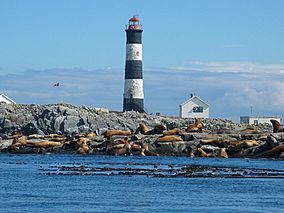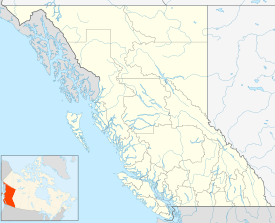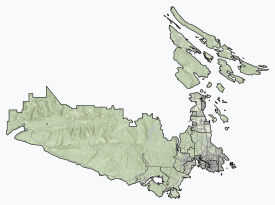Race Rocks Ecological Reserve facts for kids
Race Rocks Ecological Reserve is a special protected area at the very southern tip of Vancouver Island in British Columbia, Canada. It's located where the Strait of Juan de Fuca meets the open ocean. This reserve is a fantastic place for marine life because of its unique ocean currents and rocky reefs.
Quick facts for kids Race Rocks Ecological Reserve |
|
|---|---|
|
IUCN Category Ia (Strict Nature Reserve)
|
|

|
|
| Location | Metchosin, British Columbia |
| Nearest city | Langford |
| Area | 220 ha (540 acres) |
| Designation | Ecological Reserve |
| Established | 1980 |
| Governing body | BC Parks |
Contents
What Makes Race Rocks Special?
This protected area covers about 3 square kilometers (1.2 square miles) of ocean, rocks, and reefs. It's important to know that the small piece of land with the historic Race Rocks Lighthouse and foghorn is not part of the reserve. That land is managed by the Canadian Coast Guard.
Amazing Marine Life
Race Rocks is located in a spot with very strong ocean currents. These currents bring in lots of nutrients, which helps a huge variety of marine life to thrive. It's like a busy underwater city!
You can find many different kinds of animals and plants here, including:
- Marine mammals like seals and sea lions
- Many types of sea birds
- Lots of different fish
- Marine invertebrates (animals without backbones, like crabs and starfish)
- Various kinds of marine algae (seaweed) and sea grass
Seals and Sea Lions
Race Rocks is a popular spot for California sea lions and Steller sea lions (also called Northern sea lions). They use the rocks as a "haulout area," which means it's a safe place for them to rest out of the water.
It's also a "birthing rookery" for Harbour seals. This means it's where they come to have their babies. Race Rocks is also the most northern place on the Pacific Coast of North America where Northern elephant seals give birth.
History of Race Rocks Protection
The idea to protect Race Rocks started in 1978. Students from Pearson College UWC, along with their teachers Garry Fletcher and Marks McAvity, did a marine science project there. They discovered how incredibly diverse and important the area was for nature.
Becoming an Ecological Reserve
Because of their findings, the rocks and surrounding waters were officially protected in 1980. It became an ecological reserve. This means it's a special area set aside to protect its unique plants, animals, and natural features. It was managed together by BC Parks and Pearson College UWC.
Tidal Power Project
Later, in 2006 and 2007, an experimental project called the Race Rocks Tidal Power Demonstration Project was set up. This project tested how to create electricity from the ocean's tides. After six years of research, the tidal energy generator was removed.



